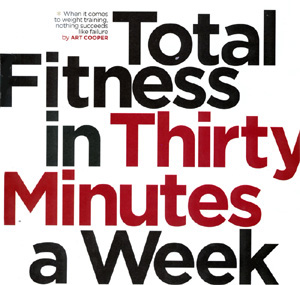

I
WAS AT A PARTY A WHILE BACK, sipping a cranberry juice and avoiding the
hors d'oeuvres, when I spotted my friend Aimee Bell, a Vanity Fair senior
editor, across the room, flexing her biceps and flashing a firm thigh and
muscular calf. She looked fit and fabulous and told me she owed this
pulchritude to an exercise program called slow motion, -which requires
only a half-hour workout once a week. I was a couple of months into a diet
that would eventually result in a sixty-pound weight loss, and I realized
that dieting without exercising was a surefire prescription for failure.
Intrigued but extremely skeptical, I went over to see Adam Zickerman, who
runs the InForm Fitness Studios in midtown Manhattan, where Ms. Bell found
her muscles. A handsome, muscular former college swimmer, Zickerman, 37,
explained the program and the assortment of weight-training machines—the
Leg Press, the Hip Adduction, the Leg Extension, the Lat Pulldown, the
Chest Press, the Biceps Curl and the Shoulder Press, among others. Sizing
me up, he smiled the smile of a proprietor of a medieval torture chamber.
Yielding to the masochist within, I signed up on the spot. I've been at it
for eight months now. Having recently completed a book, Power-oj-io: The
Once-a-Week Slow Motion Fitness Revolution, to be published this month by
HarperCollins, Zickerman talked with me about his groundbreaking program.
What is the philosophy behind Power-of-io? It is based on the repetition
of lifting moderate -weight slowly, lifting it in ten seconds and lowering
it in ten seconds. This eliminates explosive momentum from the movement.
By slowing down the movement, you achieve greater intensity. The idea is
to take muscles to failure through repetition. As you become stronger,
more weight is added so you -will always achieve muscle failure. It is
also safer. Now anybody of any age, at any fitness level, can engage in
high-intensity training and not worry about getting hurt. Form and proper
breathing are critical. It must be one smooth, continuous movement. No
locked joints. No resting at the bottom. Going to that threshold of
failure where you can't lift the weight anymore but you push the weight
ten seconds beyond that point.
Exercise is the first of what I call
"the Three Pillars" of the Power-of-io. The second is nutrition, and the
third is rest and recovery, which is something most programs completely
neglect. After an intense,
rigorous workout, your body needs five to
seven days to nurture and build itself.
What should be the goal of
exercise? The goal should be to build muscle. Any other goal you have will
come from that. Name it: slimming down, losing body fat, toning up. More
muscle means higher metabolism, -which also increases bone density. And
there are so many studies that point to the fact that strength training is
as beneficial to the heart as conventional cardiovascular activities, if
not more so.
You've been training me for eight months and the results
are spectacular. I can leg press 500 pounds, and I'm more fit than I've
been since I was in my twenties. How do you respond to critics who say you
can't really befit if you work out only a half hour a week and don't do
serious aerobic exercise? Well, if I may generalize, most critics believe
you can't possibly burn enough calories -working out once a week. But
exercise is not about burning calories. The activity is about building
muscle mass, and you need muscle mass to burn
calories for you. Critics
also believe that muscles atrophy within twenty-four to forty-eight hours.
That is not true, and you are a perfect example of the fallacy. If, in
fact, atrophy does occur within twenty-four to forty-eight hours after
exercising, how do you explain the fact that you come to me once a week
and you get stronger and stronger each week?
Over the past eight
months, I've dropped sixty pounds by dieting and exercising regularly.
Give our readers some advice about diet and nutrition. What foods should
be avoided? Is there anything we can eat that really tastes good? The most
important thing is portion control. Your body can digest and metabolize a
certain amount of food per unit of time, and if you eat more than it needs
it -will automatically store that food as fat. I recommend small, frequent
meals and snacks, perhaps six a day. I want to say there is no such thing
as bad food. You can pretty much have anything you want as long as your
portions are controlled. But having said that, there are certainly refined
sugars and starches the body loves to store as fat. I suggest you avoid
•what I call the white foods, specifically pasta, white bread, processed
bread, white rice and, of course, candy of all sorts. I think whole-grain
breads, whole-grain rice, fruits and vegetables are fine.
Do I have to
give up martinis, wine and beer? A lot of studies show that a glass of
wine a day is healthy for your heart and circulation. But you have to
drink in moderation. Alcohol contains a lot of calories and converts to
fat very quickly. I drink, but if I'm looking to reduce body fat and
reduce quickly, I -watch what I drink very carefully. I advocate a free
day: If you eat very nutritionally six days a -week and eat and drink what
you'd like on Sunday, you'll still maintain your weight, or even lose
weight.
Why is your stomach growling? I haven't had lunch yet.
What
do you have for lunch? I go to this little place where you get a bowl of
lettuce and the guy behind the counter puts in -whatever you want, good
foods like avocado, cherry tomatoes, chickpeas, tofu for protein, and I
put a very light dab of dressing on it.
There is nothing I could
possibly say after that. & Art Cooper is GQ"s
editor-in-chief.